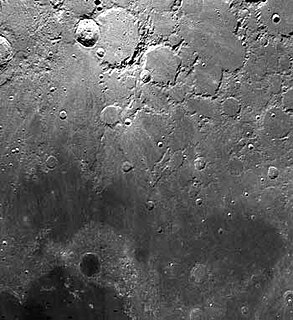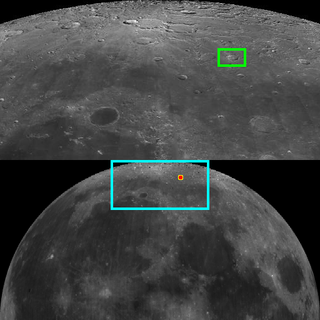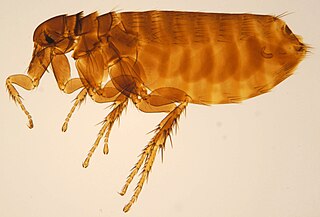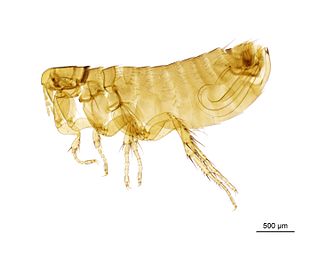
Mare Frigoris is a lunar mare in the far north of the Moon. It is located in the outer rings of the Procellarum basin, just north of Mare Imbrium, and stretches east to north of Mare Serenitatis. It is just north of the dark crater Plato.

Archytas is a lunar impact crater that protrudes into the northern edge of Mare Frigoris. To the northwest is the comparably sized crater Timaeus, and the smaller Protagoras lies in the opposite direction to the southeast. Further to the southwest, beyond the opposite edge of the mare, is the dark-floored crater Plato.

Baily is the remnant of a lunar impact crater on the boundary between Mare Frigoris to the north and Lacus Mortis to the south. The crater interior has been flooded by lava in the past, and only the northern half of the crater rim remains relatively intact. There is an outward bulge in the northeastern rim, possibly the remnant of another crater formation that once overlapped Baily. The crater interior is flat and relatively featureless, with no impacts of significance. The surviving outer rim reaches a maximum elevation of about 0.5 km.

Fontenelle is a lunar impact crater that is located along the northern edge of Mare Frigoris, in the northern part of the Moon. To the northeast is the remnant of the crater Birmingham. Due to its location, this crater appears oval in shape when observed from the Earth because of foreshortening.

Bouguer is a lunar impact crater that lies along the southern edge of the Mare Frigoris, to the north of the crater Bianchini. To the west-southwest of Bouguer, along the same shore of the mare, is the crater Foucault. Nearly due west is the more prominent Harpalus, and to the west is La Condamine.

C. Mayer is a lunar impact crater that is located at the northern edge of the Mare Frigoris, due north of the prominent crater Aristoteles. Also to the south, but only a third as distant, is the smaller crater Sheepshanks. Due east of C. Mayer is the flooded crater Kane.

Foucault is a small lunar impact crater that lies along the southern edge of Mare Frigoris, to the southeast of the crater Harpalus. In the rugged terrain to the south of Foucault is Sharp. The outer perimeter of Foucault forms a somewhat irregular circle, with slight outward bulges to the south and northeast. The inner wall of the rim is not notably terraced, and slopes down directly to the uneven floor. It is named after physicist Léon Foucault, most famous for the Foucault pendulum.
Arthrosporum is a genus of lichenized fungi in the family Ramalinaceae.

Isopogon ceratophyllus, commonly known as the horny cone-bush or wild Irishman, is a plant of the family Proteaceae that is endemic to the coast in Victoria, South Australia and on the Furneaux Group of islands in Tasmania. It is a small woody shrub that grows to 100 cm high with prickly foliage. It is extremely sensitive to dieback from the pathogen Phytophthora cinnamomi

Ceratophyllus gallinae, known as the hen flea in Europe or the European chicken flea elsewhere, is an ectoparasite of birds. This flea was first described by the German botanist and entomologist Franz von Paula Schrank in 1803.

Ceratophyllus is a widespread genus of fleas found in temperate climates. Some of its members include the chicken flea, Ceratophyllus gallinae, and the poultry flea, Ceratophyllus niger.
Ceratophyllus breviprojectus is a species of flea in the family Ceratophyllidae. It was described by Liu, Wu and Wu in 1966.

Ceratophyllus columbae is a species of flea in the family Ceratophyllidae. It was described by Gervais in 1844.
Ceratophyllus ciliatus is a species of flea in the family Ceratophyllidae. It was described by Baker in 1904.
Ceratophyllus phrillinae is a species of flea in the family Ceratophyllidae. It was described by Smit in 1976.

Ceratophyllus garei, the duck flea, is a species of flea in the family Ceratophyllidae. It was described by Rothschild in 1902.
Ceratophyllus gilvus is a species of flea in the family Ceratophyllidae. It was described by Karl Jordan and Charles Rothschild in 1922.
Ceratophyllus qinghaiensis is a species of flea in the family Ceratophyllidae. It was described by Guangdeng and Liming in 1985.
Clostridium frigoris is a bacterium from the genus of Clostridium.
Glaciimonas frigoris is a Gram-negative, psychrophilic, rod-shaped and motile bacteria from the genus of Glaciimonas which has been isolated from the permafrost from Siberia. Glasciimonas frigoris has been shown to grow well in temperatures ranging from -5 °C to 25 °C.










